During World War II most anti-aircraft artillery rounds used explosive fragmentation warheads that scattered small pieces of the shell in all directions around the explosion. Early anti-aircraft artillery rounds used a time delay fuze that was set to detonate a specific time interval after firing. This time delay was calculated to detonate the shell at a desired altitude and was set into the projectile before firing. The time between the calculation of target height and actual firing of the gun caused significant errors, and the error increased as the target speed increased. Often the projectile exploded before reaching the target's altitude or it passed by the target before exploding.
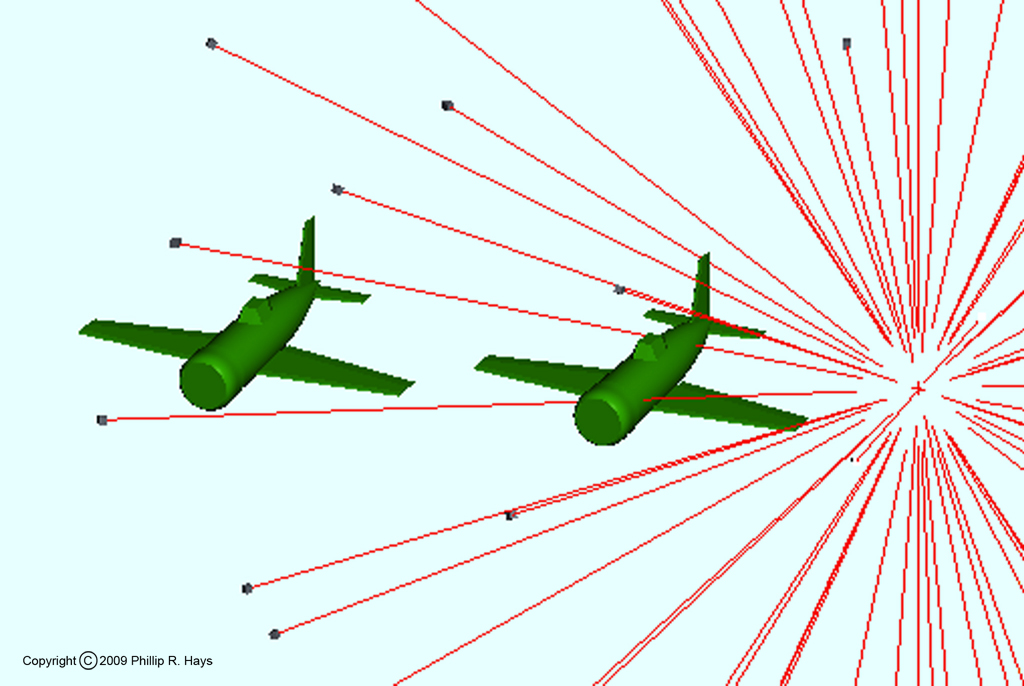 The development of the radio proximity fuze by Johns Hopkins University Applied Physics Laboratory (APL) during the war improved anti-aircraft accuracy greatly,
causing the projectile to detonate when it came close to a target. However, fragmentation warheads had low lethality. During the war many airplanes returned from
missions with dozens of holes caused by shrapnel and bullets, with no serious damage. Unless a piece of shrapnel hit a critical component, such as a
crewman or an engine, all it did was punch a small hole in the aircraft skin.
The development of the radio proximity fuze by Johns Hopkins University Applied Physics Laboratory (APL) during the war improved anti-aircraft accuracy greatly,
causing the projectile to detonate when it came close to a target. However, fragmentation warheads had low lethality. During the war many airplanes returned from
missions with dozens of holes caused by shrapnel and bullets, with no serious damage. Unless a piece of shrapnel hit a critical component, such as a
crewman or an engine, all it did was punch a small hole in the aircraft skin.
A major problem with fragmentation warheads is that the distance between fragments increases rapidly as they move outward from the explosion. At some distance the space between fragments is larger than the dimensions of the target and the chance that a fragment will hit the target is very small. To have a high probability of causing serious damage the shell must explode very close to the target where blast effects become significant. Further studies at APL in 1944 showed that for shrapnel to penetrate deep into a target it needed a velocity near 10,000 feet per second, much higher than the 3,000 to 4,000 feet per second common with anti-aircraft shells.3 Clearly the fragmentation shell was marginally effective.

Direct attack on an aircraft's airframe is the most effective method of destroying the target. The airframe is the largest component and cannot be protected. The effect of damaging the airframe may be immediate disintegration of the target. Experiments were conducted using larger fragments that might be sufficient to cut through structural elements in an aircraft. Artillery shells were machined with parallel grooves as shown in the picture.3 When the shells exploded they broke apart into long rods which were much more massive than small fragments, and were capable of cutting through heavier parts of an airplane. When they ripped through the aircraft skin the resulting gash often tore open in the airstream causing great damage. However, these shells produced a relatively small number of rods, and like ordinary fragmentation shells, these rods moved apart rapidly and the chance of hitting a target decreased with range. It was necessary to explode the shell very close to the target. Still, these shells were considerably more lethal than ordinary fragmentation rounds.
During World War II antiaircraft fire wasn't very effective. Dozens of rounds had to be fired at aircraft targets to achieve a single hit, and often not enough damage was caused to prevent the aircraft from continuing to its target. Postwar improvements in guns and tracking systems were matched by improvements in airplane construction and speed. Long range and high accuracy, necessary to engage higher speed targets, are not possible with guns. Consequently, the prospects of defending the fleet from air attack with antiaircraft guns was not good.8 This prompted the development of long range, high speed, highly accurate guided missiles.
Rod Fragmentation Warhead
When the Johns Hopkins University Applied Physics Laboratory began development of Talos they realized that they needed a more effective warhead for the missile. Unlike anti-aircraft gunfire, which attempted to fill the air with numerous rounds to improve the chance of hitting a target, only one or two missiles were to be fired at each target. They must have a much greater probability of success than an anti-aircraft projectile.
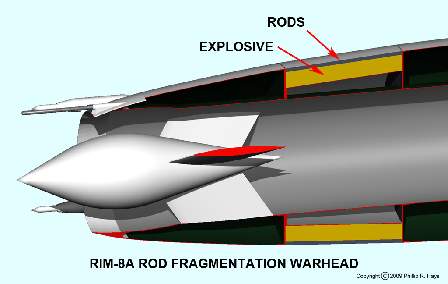
The initial warhead design for Talos was an adaptation of the rod fragmentation projectile. It was developed for the RIM-8A First Tactical Talos missile that was introduced to the fleet in 1959. The warhead was housed in two sections placed around the ramjet diffuser tube in a more or less cylindrical layer at the surface of the missile.6 It had a fragmentation layer composed of many individual rods that fit tightly together. Beneath this was a layer of high explosives. A space between the explosives and diffuser tube allowed cables, waveguides and pressure sensor tubes to pass to the electronics compartment aft of the warhead.
This warhead had the same limitation of other fragmentation devices. As range increased the chance of hitting a target dropped rapidly. Further, studies of aircraft damage indicated that to destroy larger aircraft it is necessary to cut from two thirds to the full length of a structural section to achieve a high kill probability. This required rod fragments several feet long, too large for any practical warhead.1
Continuous Rod Warhead
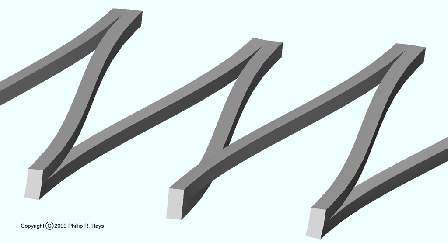
In 1952 an idea was proposed to connect many rods together to create a large circle.3, 7 Each rod would be connected at one end to its neighbor on one side and at the other end to the opposite neighbor. The rods would be folded together into a compact package surrounding a cylindrical explosive charge. When the warhead exploded the rods would be blown outward, but still remain attached at the ends so they would expand into a circle. With no gaps between rods the probability of hitting a target would be 100% within the radius of the circle if the target was in the path of the rods, and the resulting damage would span the aircraft. This configuration was far more effective than a dispersed pattern of rods.
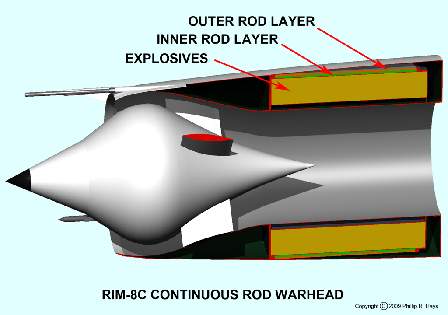
This idea was developed into the RIM-8C warhead for the Extended Range Talos missile that was introduced in 1960. Like the original warhead design the new continuous rod warhead was placed at the surface of the missile, in two "C" shaped sections surrounding the ramjet diffuser. This warhead produced two semicircular expanding sections. The outer part of each warhead section was two layers of rods welded together to form a continuous rod. Inside this was the explosive.1 A space between the explosive and the diffuser tube allowed passage of cables and tubing from the antennas and pitot tube to the electronics section aft of the warhead.
The First Tactical Talos and the Extended Range Talos missiles were produced in two versions. One had a conventional warhead as described above (RIM-8A and RIM-8C). The other carried a Mk 30 nuclear warhead (RIM-8B and RIM-8D). Ships were required to carry both conventional and nuclear armed missiles. Even though the nuclear missiles were never used they occupied space in the magazine and ready service trays. This limited the number of conventional missiles available. The conventional and nuclear missiles were different lengths and used different parts and assemblies.
The nuclear warhead was positioned inside the inlet innerbody that acted as the compressor for the ramjet. It was realized that with some modification a continuous rod warhead could be designed to replace the nuclear warhead. With some additional modifications to the fuzing system a single missile was designed to carry either type warhead. This was the Unified Talos RIM-8E that was introduced in 1962. All subsequent versions of the missile were modifications of the Unified Talos design. Earlier versions were removed from the fleet by the mid 1960s.
Mk 46 Continuous Rod Warhead
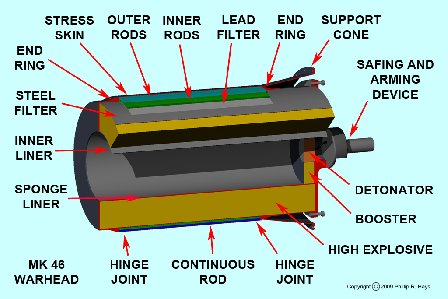
The MK 46 warhead that was developed for the Unified Talos RIM-8E had two layers of 19.25 inch long 0.25 inch square rods surrounding a hollow cylinder of explosives. The outer diameter of the rod assembly was about 16.8 inches, and the inner diameter of the explosive was 8.7 inches. The warhead was 29.5 inches long and weighed 465 pounds, with 225 pounds of explosives.7
The explosive was 75% TNT (cyclotol) and 25% RDX. The molten explosive was cast into a steel shell formed by the inner liner, a forward end plate and an outer shell. A thin silicone sponge liner inside the inner liner prevented the explosive from cracking as it cooled after casting. The 1/16 inch thick outer steel shell not only contained the explosives but it served as a filter, along with a surrounding 0.025 inch thick lead layer, to reduce the severe shock of the explosion on the rod assembly. Around the filter layers were the two layers of rods. Two end rings were welded to the steel filter to hold the rods in place, and a 0.035 inch thick steel stress skin fit over the rods and was welded to the end rings to provide structural rigidity.3, 6
At the rear of the warhead was the safing and arming assembly composed of the safing and arming device, the detonator and a booster explosive charge. This assembly fit within the rear end of the steel inner liner. A heavy cover plate at the rear carried the warhead when it was mounted into the innerbody assembly. A steel support cone was welded to the rear end ring and mounted to the struts that attached the warhead to the missile airframe.
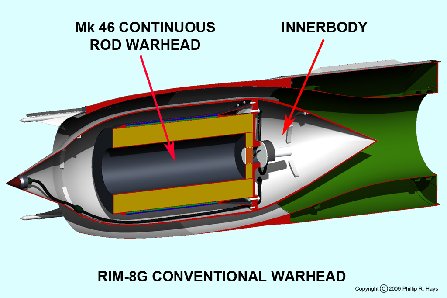
The safing and arming device contained an arming mechanism that was activated by the acceleration of launch. A proximity fuze with antennas arranged around the electronics compartment triggered a detonator charge located at the rear center of the explosive assembly. This detonated a booster charge that spread the explosion to the main explosive charge. The rod assembly was located forward a distance sufficient to allow the explosive shock to form and move evenly through the explosive cylinder to ensure fairly constant acceleration through the length of the rods.4
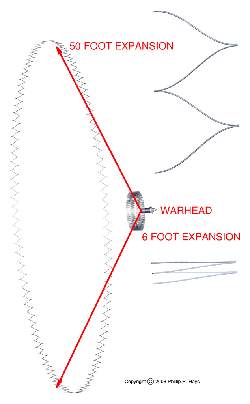
Unlike the earlier warheads that had the rods arranged around the outer surface of the missile and had to pass through only a thin skin, the Mk 46 rods had to penetrate the innerbody shell and pass through the missile structure. This posed a problem of deforming the rods and breaking apart the expanding ring. The parts of the nose cowling were distributed around the warhead to cause minimum distortion of the expanding rods. The missile structure absorbed about 30% of the kinetic energy of the rods, reducing the initial velocity from 5300 to 4600 feet per second. Impact with the missile structure had the positive effect of reducing the gap between inner and outer layers of rods, and this helped maintain continuity of the ring.7
The Mk 46 produced one continuous circular expanding ring. It expanded with full continuity to a radius of about 60 feet, and was 90% continuous at a radius of about 90 feet. If a rod struck a thin target edge on it broke into two parts, with the most damage occurring before the rod broke. If a rod hit a thick surface it snapped into three parts, with the center part doing the most damage.7
W-30 Nuclear Warhead
One of the problems with the early Talos homing system was the inability to distinguish individual targets in a crowd. If aircraft were spaced the right distance apart in a formation the missile might fly between them and detonate far enough from any target to have a low kill probability. This, combined with the limited number of targets the fire control system could engage, made Talos susceptible to saturation attacks by large numbers of aircraft.
In 1951 work was underway to develop a small nuclear warhead that could be delivered by aircraft. The diameter of this W-30 warhead was smaller than the Talos missile so it looked as if it could be used in Talos. A modified version of the missile was designed to carry the W-30 in an innerbody that formed the compressor of the ramjet engine. The first flight tests of the prototype RIM-8B missiles were conducted in 1953, only 18 months after design work started.
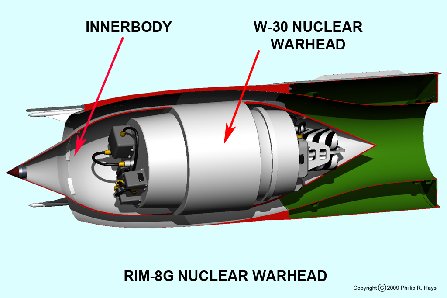
The nuclear warhead was seen as a solution to the saturation threat. With a kill radius of 1000 to 2000 yards the warhead could destroy several targets with a single blast. Gust loading would be the primary cause of damage at long range, with contributions from overpressure and thermal radiation. The knowledge that Talos was nuclear capable would cause enemy strategists to space their aircraft far apart to reduce the effectiveness of a single nuclear warhead. If attackers increased the distance between aircraft the conventionally armed missile would no longer have trouble resolving targets.2
Development of the W-30 warhead was carried out in a series of five atmospheric tests at the AEC testing grounds in Nevada in 1955 and 1957.5 It was the smallest nuclear warhead at the time and incorporated several new features to give it "more bang for the buck." The warhead was produced in three versions, Mod 0 - 2, all essentially the same size and weight.
Hundreds of test and training firings were conducted using modified W-30 warheads with the nuclear material replaced by inert materials, but no actual live firing shots were conducted with the nuclear armed Talos missile.
References
1. Continuous Rod Warhead, Eugene L. Nooker, U. S. Patent No. 3,490,374, January 20, 1970.
2. Evolution of the Talos Missile, William Garten, Jr. and Frank A. Dean, Johns Hopkins APL Technical Digest Vol. 3, No. 2, 1982, page 117.
3. The First Forty Years, Chapter 3, The Missile Age, Johns Hopkins University Applied Physics Laboratory, Schneidereith & Sons, Baltimore Md, 1983, page 19.
4. Innerbody Continuous Rod Warhead, Eugene L. Nooker, Charles R. Brown, Victor J. Dietz, and Harold S. Morton, U. S. Patent No. 3,223,037, December 14, 1965.
5. The Nuclear Weapons Archive, http://nuclearweaponarchive.org/Usa/Tests/index.html
6. Rod Type Explosive Warhead, Ludolph F. Wekanetz, U. S. Patent No. 2,972,950, February 28, 1961.
7. The Talos Continuous Rod Warhead, Charles R. Brown and Charles F. Meyer, Johns Hopkins APL Technical Digest Vol. 3, No. 2, 1982, page 157.
8. U. S. Navy Bureau of Ordnance In World War II, Buford Rowland and William B. Boyd, Bureau of Ordnance, Department of the Navy, U. S. Government Printing Office, 1953, 539 pages.
